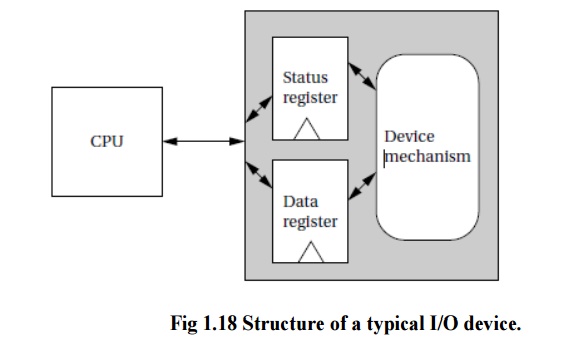Chapter: Embedded and Real Time Systems : Introduction to Embedded Computing
CPU: Programming input and output
CPU: Programming
input and output:
The basic techniques for I/O programming can be
understood relatively independent of the instruction set. In this section, we
cover the basics of I/O programming and place them in the contexts of both the
ARM and C55x.
We begin by discussing the basic characteristics of
I/O devices so that we can understand the requirements they place on programs
that communicate with them.

1. Input
and Output Devices:
Input and output devices usually have some analog
or non electronic component for instance, a disk drive has a rotating disk and
analog read/write electronics. But the digital logic in the device that is most
closely connected to the CPU very strongly resembles the logic you would expect
in any computer system.
Figure 1.18 shows the structure of a typical I/O
device and its relationship to the CPU.The interface between the CPU and the
device’s internals (e.g.,the rotating disk and read/write electronics in a disk
drive) is a set of registers. The CPU talks to the device by reading and
writing the registers.
Devices typically have several registers:
· Data registers hold
values that are treated as data by the device, such as the data read or
written
by a disk.
Status
registers provide information about the
device’s operation, such as whether
the current transaction has
completed.
Some
registers may be read-only, such as a status register that indicates when the
device is done, while others may be readable or writable.
2. Input and Output Primitives:
Microprocessors can provide programming support for
input and output in two ways: I/O instructions and
memory-mapped I/O.
Some architectures, such as the Intel x86, provide
special instructions (in and out in the case of the Intel x86) for input and
output. These instructions provide a separate address space for I/O devices.
But the most common way to implement I/O is by
memory mapping even CPUs that provide I/O instructions can also implement
memory-mapped I/O.
As the name implies, memory-mapped I/O provides
addresses for the registers in each I/O device. Programs use the CPU’s normal
read and write instructions to communicate with the devices.
3.
Busy-Wait I/O:
The most
basic way to use devices in a program is busy-wait
I/O. Devices are typically slower than the CPU and may require many cycles
to complete an operation. If the CPU is performing multiple operations on a
single device, such as writing several characters to an output device, then it
must wait for one operation to complete before starting the next one. (If we
try to start writing the second character before the device has finished with
the first one, for example, the device will probably never print the first
character.) Asking an I/O device whether it is finished by reading its status
register is often called polling.
Related Topics